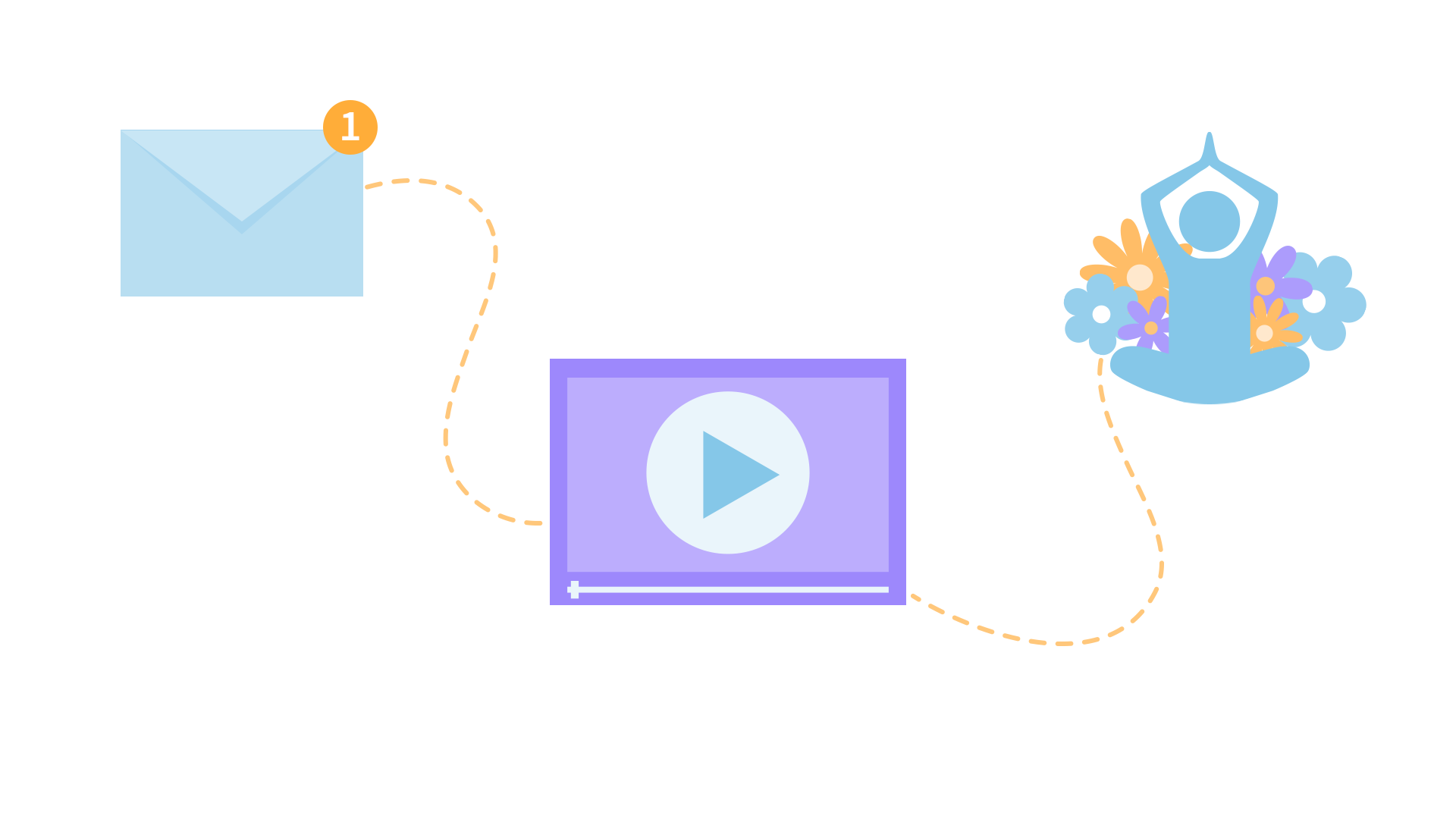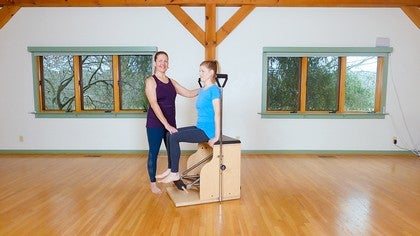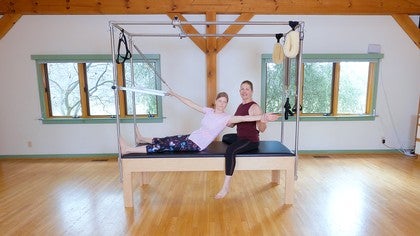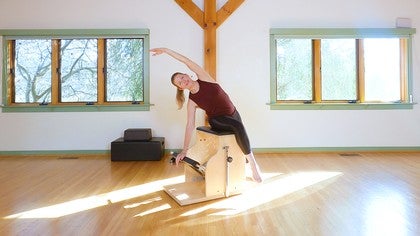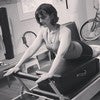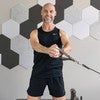Description
About This Video
Transcript
Read Full Transcript
Hi everyone. Thank you for joining me. I'm Shelly Power from Polestar Pilates. And this next session is going to be for an older adult with degenerative changes in their knees. So, we hear about this all the time, "I have arthritis.
"It's kind of painful to move. "I try not to move, "because sometimes when I initiate movement, "it actually feels worse." But I really, really wanna stress that the movement of the joints, the right way, that's the secret, is what is going to keep people with less discomfort. So, we can't magically just get away from the pain, but we can certainly improve function. You're gonna feel better. And you're gonna feel like moving, because I know sometimes when we have pain in any parts of our body, it kind of just feels like, "Eh, I'd rather not," but this is the time where you need to find the right movements.
And in Pilates, we can use the apparatus, all the different spring configurations and pedals and bars and all the things that we have to really assist you to move more than you can do on your own some days. Some days are great, you can do all kinds of things. On the days that aren't so great, we can really use the apparatus to our advantage. So again, this is for somebody who may have some wear and tear on their joints, arthritic changes. It's common, we're all probably gonna have that at some point, but the more we can stay moving, the more we're gonna wanna keep moving.
So, we're gonna start on the chair today and focus our movements here. And I'm gonna show you some differences, between what maybe the traditional exercise might look like and how we're gonna modify it for you to feel better or for your clients to feel better. So, the first movement we're gonna do is the, it has lots of names; seated leg press, double leg press, double leg pump, the seated footwork. Be sure when you're on, that you're not sitting too far back. One of the mistakes that we often make, and especially in working with somebody who has some sensitivity in their knees, is to sit all the way back and then try to push down.
Well, you can see how the top of the chair, it stops my leg from going down. So, I don't get very much movement this direction. And often what I feel like is I have to use my quadricep to push down, which actually that's not what it does. I wanna use the hip extensors. So, scoot forward, get right up close to the edge, and then you can start to press down and up and you're gonna watch how far do you push down.
Only as far as you can maintain your body upright. The moment you start to change, that would be the time to stop or at least do it a little differently the next time. And you can see how in this position, I come into quite a bit of knee flexion. So, quite a bit of bend here. I can modify this with the moon box, so that I can limit this range of motion if I need to.
And remember with this population of people, some days you feel really good and some days you don't feel so good. So, we really need to meet the client, meet our movers, meet yourself, where you can be comfortable. So, you can sit on a moon box. You could sit on a yoga block, a couple of them would be good or some sort of a cushion, that's the right height for you. Maybe you don't need to sit this high, but you could if you needed to and now I can start to press down and up.
And again, one of my focuses is I'm lubricating and moving the knee joint, but I'm also managing my body while I'm sitting upright. So, I'm trying the best I can to maintain my upright posture. I don't wanna exaggerate it, but I wanna maintain it the best I can. From here you can go into a little bit of ankle movement, first by moving the toes back. And I really stress this with my clients that anytime you're gonna do some sort of a heel raise, so it could be standing on the floor.
Maybe you're doing footwork on the reformer or on the tower bar. You wanna have the underside of your toes, actually on the surface that you're pushing against when you lift your heel. And that's important because if my foot is forward, not only does it feel like it's gonna slide off, but I'm using my muscles at the front of my shin. And that's really not where we do this movement from. So when I point my foot, I'm using the muscles in the back.
So, wiggle your feet back a little bit, and then you can begin this same movement, pressing down and up with the heels staying lifted. So again, we're working on the knee, but we're working the whole body at the same time. So, heels are lifted and you're just watching to maintain good alignments. So, you're not rolled out or rolled in as you go up and down and then hold in place and let the heels lower and lift. And this is very similar to the Achilles stretch that you might be aware of, where you're leaning against the chair with your knee, just underneath the kneecap and you're pointing and flexing.
So, this is not only helping us to strengthen and kind of energize the calf and lower leg muscles, but it's also working on deceleration. So, if I didn't have that control, you might see something like that. You also will see if you haven't done this very much and you try it, you might notice the little jittering that happens, totally normal. As you keep practicing, those muscles will lengthen, let me say that eccentric contraction or eccentric lengthening as you're doing your movement. So, that is the Achilles stretch if it's not comfortable to put pressure on your knee and lean against the chair.
If it is, you can certainly do the Achilles stretch. It's a fabulous exercise for that deceleration and also just to keep us with good dorsiflexion, this flexed position of the ankle. It's really an important thing that most of us don't have enough of anymore. So, you can take your feet wide and then you can start to add some interest to it, 'cause this, after a while, ah, it gets a little bit boring of just pushing up and down, but let's add the rest of the body to it. So, maybe you hold onto a ring or you have a TheraBand that you're stretching or a dowel, any prop could do or no prop at all.
And as I press, I can now increase the challenge, by bringing my arms overhead. This is really similar movement pattern to doing your leg arcs or your arm arcs when you're lying on the mat. But now I don't really have much supporting my body. So my proprioception, my awareness is challenged more. My balance is certainly challenged more, 'cause I'm just perched on my sit bones.
It's not a lot to really balance the body and you can do all types of different motions here. You could add rotation. If you are on a chair that had the elastics, you could be pressing up against something. Any of these movements are great and we really wanna keep involving the whole body as much as possible. It's just more interesting, once you've kind of gotten the basics down.
So, I'm gonna turn now to do this from the side and I'm not gonna use the box this time, so I'm just gonna place it away. And you might, if you have your spring tension quite high for the double leg press, when you go to single leg press, you might need to make it just a little bit lighter, because now you're pressing with one leg. Alternatively, if you had a couple of heavy springs on, you might just remove the dowel and that spring setting might be appropriate. So, just see how that goes. And you're gonna sit as far back as you can, without falling off.
And sometimes I don't have the handle in right now, but sometimes I will leave the handle in, as a point of reference, because I've seen people start to scoot back and I wonder, "Oh my gosh, are they gonna stop?" But you need to scoot back far enough, so that you're not overdoing your turnout. So, we want the turnout, for most people it's kind of aimed for 45 degrees. That's sufficient. So, you wanna sit at the back, sit tall. You can hold on at first.
And it's kind of an asymmetrical force coming into the body. So, we don't do and maybe if you're on the bus or the subway, you get that kind of jostling feeling. But a lot of us, we don't have that feeling any longer. So, it's good to practice it. The same idea here.
If I sit way over to this side, I'm not very powerful, 'cause I'm not really over my foot. And the chair stops me from pushing my leg down. So, I wanna scoot over, closer to the pedals a little bit, still feel like you're securely on the chair and then press down and up. And the idea here is to press from the back of the thigh. Some people will over recruit.
I don't know why necessarily, but they will over recruit their hip flexor on this side, even though we're moving out of hip flexion and toward hip extension. So, just be mindful that you can feel in your own hip or if you're teaching somebody this movement, feel it in their body. That there's not a lot of tension there, pressing down and pressing up and really pay attention to the alignment of the knee and the foot. And sometimes people talk about, they'll say your knee needs to be aligned over your toes, but really your knee may pass your toes and it might not get to where your toes are. So, think of it more as your knee in the same direction that your toes are pointing.
That way again, you're not gonna have any undue torque or stress at the knee. So, I'm gonna turn around and I'm gonna slide my box over and I'll show in a pinch, there's another way you can set yourself up. So, pardon my back, but I'm gonna face away from you. And if for some reason, you didn't have a box to put your foot on, you could and I'm not sure how it shows in the film, but you could put your foot just on the wooden piece at the back where the spring's attached, just under that. And that's good if you don't have any other options, but otherwise you can find a box to put yourself on, knee and toes aligned.
I am aiming my thigh down as I go. And now I've done this for a while, I know the motion. So, I am again going to do some additional movement with my upper body. Maybe I twist both ways, I might just have my arms going up and down like I did, facing the front and I can even push down. As long as the spring has enough tension to it, I might even practice a little bit of side bending.
So, I'm not going very far, but I'm again managing how do I hold all of this steady, but it's still dynamic because I have a spring under me and add some movement, some interest here, the rotation piece, I love doing rotation. It's a very important movement that we just don't get quite enough of. So, play around with those variations as you're doing all of your seated leg press, see how that feels. We're gonna transition now into the mermaid and this is another exercise that quite often we feel like it's, not all chairs are created the same, I guess. So, if you are a tinier person, but you're on a taller chair, the chair might not be the best place for you to do this movement.
So, maybe you wanna get a lower chair, like a Wunda Chair. And then that would be a little bit better suited to you. The other thing that's different about the chairs is how high up the pedals come. So, on this chair, I'm tall enough and have long enough arms that I can get my hand down. But if somebody again is smaller, they might not be able to, 'cause the pedal is pretty far away.
I have to get there before I get any support. So, just keep that in mind when you're choosing where you might wanna do your mermaid. This is a great place, because it really allows you to get the movement, without kind of a strange sitting position. So, that's the benefit of doing it here. So, I'm gonna sit on top and again pay attention to these things and you might be able to see this better, even when I face the back.
If I force someone to keep their sit bones down in their pelvis level, again, they might not be able to get to the pedals. They may have gone as far as they can go. So, sit a little bit more on the side of the hip. This leg is just hanging free. You could put a box under it if you need it.
And this leg could be a little bit more forward or if you wanna continue to open up, through the front of the hip, you could take the leg a little bit back. And now I can go into my mermaid stretch this direction and then come back up. And again, this is just another way of getting into the movement of the mermaid, the lateral flexion. Maybe you want to add some rotation, be mindful if somebody has osteoporosis and make sure that their rotation is more around a lengthened spine. So, not side bending.
If they don't, then you could go into side bending and go into rotation here and then come back up. If the foot doesn't hit the floor, you could get a box. This would be some, you could use a yoga block, whatever you want under your foot if you feel like you wanna have your foot grounded. The other variation is to not worry about the foot staying down and actually start to lift it up. This is gonna look like the star exercise, the lateral flexion exercise, but we're doing it more to get the abductors to work, like you would in sidekick.
So you can go over, feel the support here. And then if it feels good to lift your leg and you could hold here and lift and lower, there's good amount of work happening here, we wanna make sure we're not collapsed in the shoulder, but keep lifting and lowering, while you're working on your outer hip muscles and then come back up. Make sure you have enough spring support. But again, it's one of those, it might be too heavy. You might need to lighten it a little bit, but you'll find the right setting.
I'm just on one weight spring up on the top, but you might prefer to have something a little bit heavier. So again, I'm setting myself up, so that my body is already starting in a diagonal. I'm not starting with both sit bones down and the plain mermaid, going over using the support of the pedals to lengthen me. And you can see how this is a stretch from my fingertips or if we're thinking of the body from my head, all the way down the outside of my hip and down toward the floor. So again, in the sense of lateral motion, this is really important to get that full body lengthening.
And then of course you can add rotation. So going over and again, choose if you're gonna keep the spine more elongated and rotate that way or if you want to have your spine a little bit rounded and rotate that way. And if you've done this on a taller chair and you've done this on a shorter chair, you'll really appreciate the difference. The shorter chair is a much friendlier chair for most people in the middle of this exercise, but you can certainly do it here. So, let's add the variation now of lifting the leg.
So, starting to go over, getting your weight here. If you don't have your weight enough this way, you're not gonna be able to lift your leg. You won't have the right leverage. So, get into the pedal first and then hold and you can lift and lower. You might wanna try some different arm exercises, any way that you find it interesting to find your balance here and then come back up and return to sitting tall.
So, that's our mermaid and mermaid variation or you could also think of it as a variation on the star and the lateral flection. It's pretty much the same movement, just a little different intention through it, but it's again, it's a great full-body movement, which I love. So, now let's turn into the swan and you have set up options for the swan as you know, to put the chair up against the trap table if you want the leg support, but I'm doing this for somebody who may be a little bit more active. So, if they're not put a couple of boxes, put the trap table and give the legs some support. If you're gonna be lying on the rib cage, just again thinking of the age group that we're working with.
If your rib cage is touching the top of the chair here, for some people it's not super comfortable. And if the chair top is hard, you might wanna provide a layer of some soft padding for the ribs, again, in thinking of if somebody has osteoporosis. It depends on the person, but if they're a little bit more frail, you might want to pad the ribs. And this would be when you're using a box or the trap table. Now, when we're just going forward and we're going out farther, my ribs are not gonna be touching the table any longer.
So, we don't really have that precaution. Let's adjust the springs and I'm using the same spring on each side, so that I can take out the dowel and do some reciprocal movement into rotation. So, when I come on now and you could, I wasn't thinking about using the box for this, but you could, maybe not a full box, but you could put something here if you were questioning, whether somebody might go forward too much. So, you could stop the pedals with a yoga block or a half roller or something like that. So, just something to keep in mind.
And now, again, we're doing full body, but we're working on hip extension. And since we're not bending and straightening the knee a lot, this is pretty accessible to most people. So, climb aboard. And then you're again gonna find the point where you have the right leverage, everybody has to find their position on their own. So, if you're a teacher, don't really try to put the person in the right position, let them find the right position with your direction.
So, ideally your pelvis is on, your upper body is off and the legs are engaged. And if you've heard about bone rhythms before, I'll give you a second to think about what bone rhythm, what direction is happening as I lift my thighs toward extension, should I be turning my legs out or in? And I know everybody was saying in, so you can think about rotating your inner thigh, like the seam on your pants, up a little bit toward the ceiling, as you're in this position. If you feel like you need more pelvic support, you could turn out and use your glutes a little bit more, but otherwise I want you to try to stay in parallel. And then you have all the motions here of coming into extension.
You could go down a little bit farther or keep the spine straight and go into the motion a few times and try to feel like the ribs are still on the chair, even though they're not. So, we're not coming up really high. That's gonna push me off the back. But as you're coming up, lengthen and make an arc in your upper back and then pause and hold here and start to bend and straighten your elbows. Here's one of the great places to practice your pushups.
So, bending and straightening, feeling an opening, a widening at the collar bones and then pause and then pause. I'm gonna take the dowel out and do some rotation. This is where you might be able to start to introduce the feeling of swimming from the mat work. So at first, just having the elbow bend and rotate and make it 3D. So, I'm gonna push all the way down here, make sure that these ribs are coming around, as much as you feel these ribs going over and around the top.
Sometimes we mostly move the arms and we forget we have ribs all the way down to our waist. So, make sure you're spiraling around the spine in that way. And you can also add a little bit of extension to it. If it feels good to come up a little bit more. Now, here's where we can start to do some leg arcs and you might just hold the pedals steady or if I'm gonna lift my right leg, I'm going to rotate to the left.
Remember that we have our fascial and muscular connections from one shoulder blade and arm, down to the opposite hip. So, if you forget, try to touch your shoulder to the active leg and you'll remember which direction to go to, back and forth. If that's too much, you could do something a little bit farther back and you can just go through imagining the movement too. So, if you were on the trap table, you might just lift a leg, a little bit more in your mind than actually physically doing it. So, see how that feels for you.
Engaging the muscles is fine, you don't actually have to move anything, so you can work on that as well. Now, if that's too much, I have some other options for lifting the leg to the back. So, everybody does the quadruped, on your hands and knees and you lift your leg and move it. But what if you did it with straight legs and you didn't have to kneel on your knees. So, you could do this pretty much anywhere.
You could do it against a counter. Anything that's not gonna slide around. You can put your weight on and then begin to lift one leg and then the other. It's gonna feel like you don't go far enough, right? It's not a big enough movement, but really all you're trying to get to is a straight line, more or less where your leg starts to align with your torso.
We wouldn't wanna see something like that. We're not going into extension. We're just continuing to tone and work on the buttock muscles to lift the leg and a little bit of work now in single-leg standing, totally supported by my hands, but I'm at least starting to introduce, single-leg standing into the body. Now, if that feels good and that's maybe easy for you, we can go back to doing it with the pedals. And this is a variation on hamstring one or sometimes this is also called Washer Woman, and we're going to press down and lift the leg.
Now, you're on an unsteady surface. So, the pedals are gonna move a little bit. So, standing make sure that you're not letting your knees hyper extend, the legs are straight. And that's probably one of the things as a teacher, I get asked and challenged a little bit, about straightening the knee. We want the two bones, the femur on the top and the tibia on the bottom, we want them to align pretty much vertically, there's bends to them, but I don't want my knee joint to be back here, nor do I want it to be here.
I want it to be right over my ankle. So, there's a little bit of control that has to happen for me to stay in that position and not just rest back on the backs of my knees. So, just check that out and your own body and your client's bodies. And then bend forward. And traditionally hamstring one goes into flexion, but maybe again for this population, it's better to just hinge forward.
You could put one hand here first if you needed to or come to both hands being on the pedals. Step back a bit if you need to, check that the legs are active and then push down a little bit and hold. From here can you shift your weight? And maybe you just take your toes back on the floor and bring them back in, slide the other foot out and you'll feel your weight start to shift and you'll feel the pedals want to come up and down. So, make sure you're ready for this, as you start to go into your leg lift and I'm showing some things that are a little bit maybe out-of-the-box, because the people that I work with who are in this, kind of in this age group and in this state of arthritis and healthy active aging, they all want to do more.
They don't wanna do less. So, I'm just showing you some ideas of things that you can do to help challenge your clients or challenge yourself. So, play around with it a little bit more and see what you can get out of it, because we all wanna do the most that we can do. So, this is a great way to challenge yourself, but it's still supported. So spring wise, I still have a couple of weight springs on toward the top.
So, it's really supporting my body as I get into the movement. So, I hope you enjoy that one. It's kind of fun. Let's try just for fun to take the dowel out and add a little bit of rotation. So again, make sure you're ready for this.
Make sure your clients are ready for this, but we can start to add a little bit of rotation. And this is important, because we need to be able to manage ourselves when we're walking around on unsteady surfaces, stepping up and over things if we accidentally tripped a little bit. So, these motions are all important that we have the capacity to manage ourselves is kind of how I think about it. So bend forward, hands on. And remember now, as you lean into it, maybe the first thing you do is just play with this pedal moving.
So, you're aware of what's happening. And then you can just slide one set of toes back and bring it back in. You do not have to leave the floor, but you can if you want to, and you can start to notice how you shift your weight, what happens? And you could start to lift if you like. And again, I'm thinking about bringing my inner thigh up.
You could see the difference of inner thigh up or outer thigh up. That turns me sideways and I wanna stay parallel. And it's always entertaining. Can't take your eye off the ball at all with these and then come back in and come back up. So, fun variations.
So, let's go into a little bit of tricep work now. This again is, you're gonna choose if you're gonna do it from the floor or if you're gonna do it from the top to continue to work our full body motion. I'm gonna change the springs just a little bit. (wood clucking) And I'm gonna come to sit on the floor on a moon box. Just make sure you have the moon box far enough forward, that when the pedals push down, it doesn't bump into the box and I'm gonna allow the dowel back in.
And there are a few different options of this tricep press or you might be familiar with frog facing out, which is on top of the chair with the feet on the pedals. We're gonna do the ones sitting on the floor with the legs out in front. It's really important to get down to the ground safely, so that you feel comfortable. If you're comfortable kneeling, you can do the kneel down to the floor. I recommend you have a mat.
If this isn't so comfortable, I'm gonna show a different version, which doesn't require you to get to the floor. And you'll come around actually to the back of the chair. But if you can sit down low on the floor, I like to have the feet a little bit apart to squat and then you can support yourself with your hands and then take your feet out in front of you. And then the hands go back onto the pedals. And you just wanna make sure you have enough space, between the box and the pedals, so they don't rub against each other.
So sitting tall, there's a little tendency to wanna lean back. So don't do that, stay up tall and then begin to bend and straighten the arms, into the tricep press. And this is a great exercise, because it really keeps us upright and open in the chest, which we tend to be down here a lot today, by sitting and our using our phones and just not being super mindful about our posture. So, as you're pressing up and down, you'll feel that sense of lift and be mindful of the front of the shoulder. That when you're in this position, it's okay to see this rounding place, that's fine, but you wouldn't want your shoulders to go forward.
So, as you're coming into the tricep press, keep the arm pulling back just a little bit, just not so much that you arch, but keep the shoulder and the whole front of the chest open. So again, if this position isn't comfortable for you, you can certainly do the tricep press up here. Hands at the edge and just walk your feet out a little bit. And you can do the same motion here. It has the same consideration for the shoulder position.
We wouldn't wanna see something like that. That's not good alignment. Here's the good alignment to go up and down. And if you're new to those tricep presses, this is a good opportunity to use your legs a little bit more. As you become stronger in your arms, you don't have to use your legs much at all, but it's good to kind of play back and forth, so you can really start and feel comfortable with the movement.
So, that's the tricep press. I gonna put the handles in now and the next ones are all gonna be standing exercises that we'll do. And I like to have the handles there, even if I'm not using them. I like to have them just in case I lose my balance. Sometimes it's actually helpful in getting me aligned properly to just hold on a little bit.
I'm gonna have them down a little bit to start. And then for our last exercise, I'm gonna put them I'm gonna up. All right. So, we've talked about keeping the pelvis level. We talked about that when you were doing the hamstring one variation, but it's also important to make sure that we have motion in the low back and in the hips and pelvis.
So, this exercise is gonna help you to get that. It can be quite small. It doesn't have to be a very large motion and I'm gonna drop my springs down to just one at the top and I'm gonna use the moon box again or something like the moon box that is not gonna slide or slip around and is pretty steady, so it doesn't wiggle either, and you're gonna step up onto it and then put this foot on the pedal and you kind of have to push it down a little bit, just to were your two feet are level. And it won't be all the way down. From here you're gonna, and when I turn around to the back you'll see it even more.
You're going to let one side come up and then let that side go down. So, your pelvis is tilting one way and the other. And so not only am I getting some stretch and some work through the outer hip muscles, I'm also putting some motion into my lower back, just a gentle little bit of lateral flexion, which again, the more movement we have available, the better our whole body feels. So, it's just a small little motion. When I turn around, you can have your foot in the same place or you can start to experiment as you're doing it with your foot being a little bit farther back, this is more like stepping.
So, if I was walking forward, at some point my leg would be behind me a little bit and you can see how that feels. You could also try it with the foot forward or you can simply maintain it with the two feet aligned together. (lady clearing throat) Most of the time I don't really let go. I don't always challenge my balance here, but you could if you were brave, you wanted to challenge your balance and see how it is and see if you can go without hands, but that's not totally necessary, but you can see how my pelvis, as I'm doing the motion is starting to move up a little bit on one side and down on the other. And you will definitely feel this in the static leg, the leg that's on the box.
You will feel the muscles working and again, single-leg stance, super important. That's what we're kind of working and conditioning for to be able to balance on one leg really comfortably and feel secure with that motion. The next one we're going to do is a common one, which is the standing leg pump. I'm gonna make my springs a little heavier and go back to two weight springs. (wood clucking) And this is preparing us for stepping up and down stairs, walking, all of our functional movements that we need.
Foot on, pressing down and then adjust where this foot is. So, instead of being back here, you're actually a little bit forward and then slowly with control, let the pedal come up. Now, a couple places to put your attention as you're doing this. One, if for some reason today, this amount of knee bend or knee flexion doesn't feel good, you can do exactly what I told you not to do. You can shift your weight back a little bit back here, just a little bit to get the motion, the movement in the hip and the movement in the knee.
Just remember this isn't functional. This is not, if I was going to take another step and climb up onto the chair, from way back here I can't do it. I'm not in the right place. So, functionally we wanna be forward, but sometimes you have to make modifications. So, it's okay to lean back a little bit if you need to.
Then you can work on your balance, the other place I want you to turn your attention is the back leg or the standing leg. And is that leg energized? And are you up on top of it? I'll show you the difference as we change sides. You might see something more like this, hip sitting to the side or the knee hyper extending and just kind of hanging out here.
So, we wanna pull up and be lifted up on top of the leg bones. Like your leg bones are holding you up, 'cause they really are right in the center of your pelvis. This is our leg press. And again, use hands as much as you need. Maybe you use fingertips and then eventually you can use no hands.
And it's quite a bit to manage at first, the first couple times you do this one, it usually feels like this. And then right away, your whole nervous system goes, "Okay, let's focus." And then you'll find the right position, so that you can be successful with this movement. And so you can see how this really could be something, about climbing stairs. So, it's the same position you would be in if you were going to do something like that. Important again to get the side motion that we talk about or the lateral stresses, and I'm gonna make the springs just a little bit lighter and cross over and do some sideways work.
You have options to cross and you have options to go here and I'm gonna do this one today for our session. So, I love this version of the standing leg pump, where we're facing the side and pushing down, because life really isn't just straight front and back. We need to be able to deal with forces and things that are coming from the side or are diagonal. And this is a great exercise to help with that, 'cause if I'm not controlling it, I'm gonna start to tip over to the side. As I'm going up and down, I'm thinking almost of the position, even though it's only on one leg, of a big full squat.
So, make that's something you want to get back to be able to do. And you think, "Ah, I could probably not do that." Well, maybe you could. And this is a way to kind of step into that. So, at least I'm in the position of a big full squat, even if I'm not down all the way on the floor, sitting down very low to the ground. The other thing I really, really like about this movement is it helps to kind of lengthen again and get us into that wide movement at the inner thigh, but it also starts to have an effect on the pelvic floor muscles, just by the nature of this movement.
Not that you're doing anything, it's just the movement is putting these muscles in a little bit of a stretch and then letting them come back. And we know that the pelvic floor muscles, often are a little too active. They don't lengthen well, but sometimes they're also a little bit lax and they don't contract well. So, this is just a really nice way to just, you're doing well, good things for the pelvic floor as you're pressing up and down, it's a very dynamic system. So, movement and breath are really the best things to help that.
As I turn around, I want you to be really paying attention to where you're placed. Are you too close? Do you feel kind of squashed? Are you too far away and you don't have enough power to push down. When you set yourself up, the standing leg is a little farther back and the leg up on top of the pedal is a little bit forward.
That's gonna put you in the best alignment to be able to go in and out of this movement. And you'll probably start to feel your outer thigh muscles, maybe your buttock muscles a little bit getting tired, 'cause it's a lot to manage yourself, holding in this position, pressing the pedal up and down. So, definitely take a break if you need to, if you just need to stop for a moment or you could stop and come back to it at another time or in another workout. So, up and down and really have again the feeling too of letting the leg float up. So, I'm not using my muscles to bring the pedal up, the springs are doing that as I'm going up and down.
Now, you might be familiar with the forward lunge on the chair. Sometimes it's called going up front. It's part of the Mountain Climbing Series. And you might think that's totally inappropriate for this group of people, but never say never. You don't know what somebody can progress to be able to do.
What I am gonna do is change the start of it. So, for most people to push this pedal down and start going up here with this much knee flexion, that's probably not your best bet. It's not the way that's gonna really be accessible to this person. So, I'm gonna have you get on a different way and you're gonna create kind of a ladder or some stepping to get up onto top of the chair. And then you might be able to do some part of the movement and think how cool that would be.
To be able to do this challenging movement when you thought maybe you didn't have much movement to you. So, it's just something to keep in mind. This won't be for everybody, but it might be for some, you or your clients. So, I'm gonna put the handles up a little bit, so I have help with my balance. And then again, instead of stepping up from the pedals, I'm gonna step up from the back and I'm just gonna create stairs to climb up as I'm gonna do the movement.
I'm also putting on quite a bit of spring tension, so that I have a lot of assistance. I don't wanna have to work very hard at first. I wanna be able to feel what the movement is and focus on my alignment more than struggling to go through a motion. So, I'm gonna take the box and I'm gonna place it to the back of the chair. You can place it to the side a little bit or right behind.
And this might be the right height. You might have to add an intermediate step, but you can see how now I can step up and I can climb to the top of the chair with relative ease and I've got the handles, so now I feel really secure in my balance. So, I'm gonna turn around and I'm going to step back. And a lot of teachers I've heard they say, "Oh, don't look down. "You have to keep your posture." Please let your clients step back and put their foot down and look at it.
So, they feel secure with that. And just like we did in the standing leg pump, traditionally we want you to be forward, but maybe you need to be back a little bit to have not quite so much flex in your front knee. So, this is something where you're gonna really have to play around with this. Are you going for the functional, I'm climbing stairs and I need to get forward over my ankle or are you working the thigh muscles, the glutes, the quadriceps, you're working through all the muscles of the foot in lower leg in a position that you can do and feel really good about? That's more important than always being in exactly the right position, because the right position for you might be different than somebody else.
So again, I'll show both versions. So, ideally if knee flex is not a problem today, you have the range of motion and it's comfortable. You keep your weight a little more over your ankle and forward. This is gonna put you in more hip and more knee flexion. If it's not so comfortable today, you can let your weight go back a little bit.
So, the knee feels a little more open as you're going up and going down. And then again to get down, you're gonna come up to the top, turn around, step back, have people look, let them look at where they're going, because that's gonna aid in their confidence and then step all the way down. So, I hope that these exercises and even more than the exercises, the kind of the theory behind it of meeting these people, where they are on any given day, they may feel relatively pain free, they can do a little bit more. Some days they're not. It's also important that you help them, come up with some not limits like hard limits, like you could never do this, but kind of daily limits or movement limits that they can move relatively pain free with ease.
That's really important. We don't wanna push into pain. We don't wanna push into things that we just really aren't prepared for. The tissues will change, right? The muscles will get stronger.
You'll have more mobility. Your posture will be better, but sometimes this degeneration really isn't gonna change. So, you might always have that little bit of arthritis. So, be very sensitive to that, help your clients know how to do enough, so they're progressing, but not to do too much where they're really getting set back. So, I hope these things have been helpful.
I look forward to hearing your comments.
Knee Health: Whole Body Movement for Knee Function
Comments
Upon further inspection, it looks like the apparatus being used in this class is the Balanced Body Combo Chair. We have a link to the exact model here for your convenience: https://tinyurl.com/yhhuzr8h
We hope this information is useful in your search! If you have any additional questions, please feel free to reach out to us!
You need to be a subscriber to post a comment.
Please Log In or Create an Account to start your free trial.
